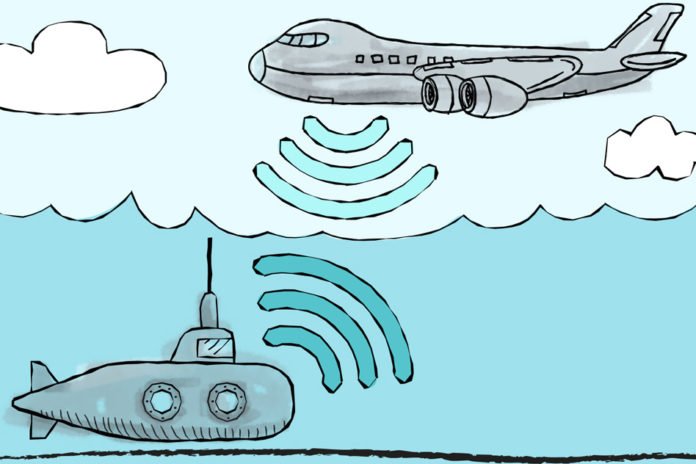MIT researchers have now solved a longstanding problem: direct data transmission between underwater and airborne devices. They have designed a system that tackles this problem in a novel way.
An underwater transmitter guides a sonar signal to the water’s surface, causing little vibrations that compare to the 1s and 0s transmitted. Over the surface, an exceptionally delicate receiver peruses these minute disturbances and decipher the sonar signal.
Fadel Adib, an assistant professor in the Media Lab, who is leading this research said, “Trying to cross the air-water boundary with wireless signals has been an obstacle. Our idea is to transform the obstacle itself into a medium through which to communicate.”
Scientists dubbed this system as translational acoustic-RF communication (TARF). Although, the system is currently is in its early stage. Scientists believe that the system could open new capabilities in water-air communications.
Adib explained, “Using the system, military submarines, for instance, wouldn’t need to surface to communicate with airplanes, compromising their location. And underwater drones that monitor marine life wouldn’t need to constantly resurface from deep dives to send data to researchers.”
“Another promising application is aiding searches for planes that go missing underwater. Acoustic transmitting beacons can be implemented in, say, a plane’s black box. If it transmits a signal every once in a while, you’d be able to use the system to pick up that signal.”
TARF includes an underwater acoustic transmitter that sends sonar signals using a standard acoustic speaker. The signals travel as pressure waves of different frequencies corresponding to different data bits. For example, when the transmitter wants to send a 0, it can transmit a wave traveling at 100 hertz; for a 1, it can transmit a 200-hertz wave. When the signal hits the surface, it causes tiny ripples in the water, only a few micrometers in height, corresponding to those frequencies.
To achieve high data rates, the system transmits multiple frequencies at the same time, building on a modulation scheme used in wireless communication, called orthogonal frequency-division multiplexing. This lets the researchers transmit hundreds of bits at once.
Positioned in the air above the transmitter is a new type of extremely high-frequency radar that processes signals in the millimeter wave spectrum of wireless transmission, between 30 and 300 gigahertz.
The radar, which resembles a pair of cones, transmits a radio signal that reflects off the vibrating surface and bounces back to the radar. Because of the manner in which the signal slams into the surface vibrations, the signal comes back with a somewhat balanced edge that compares precisely to the information bit sent by the sonar signal. A vibration on the water surface representing to a 0 bit, for example, will make the reflected signal’s angle vibrate at 100 Hertz.
Adib said, “The radar reflection is going to vary a little bit whenever you have any form of displacement like on the surface of the water. By picking up these tiny angle changes, we can pick up these variations that correspond to the sonar signal.”
A key test was helping the radar distinguish the water surface. To do as such, the specialists utilized an innovation that distinguishes appearance in a situation and sorts out them by distance and power. As water has the greatest appearance in the new system’s environment, the radar knows the distance to the surface. Once that is built up, it zooms in on the vibrations at that separation, disregarding all other nearby disturbances.
The next major challenge was capturing micrometer waves surrounded by much larger, natural waves. The smallest ocean ripples on calm days, called capillary waves, are only about 2 centimeters tall, but that’s 100,000 times larger than the vibrations. Rougher seas can create waves 1 million times larger. This interferes with the tiny acoustic vibrations at the water surface. It’s as if someone’s screaming and you’re trying to hear someone whispering at the same time.
To address this, scientists developed modern signal-processing algorithms. Natural waves happen at around 1 or 2 hertz — or, a wave or two moving over the signal area consistently. The sonar vibrations of 100 to 200 hertz, in any case, are a hundred times quicker. In view of this frequency differential, the algorithm zeroes in on the fast-moving waves while disregarding the slower ones.
The researchers took TARF through 500 test runs in a water tank and in two different swimming pools on MIT’s campus.
In the tank, the radar was placed at ranges from 20 centimeters to 40 centimeters above the surface, and the sonar transmitter was placed from 5 centimeters to 70 centimeters below the surface. In the pools, the radar was positioned about 30 centimeters above a surface, while the transmitter was immersed about 3.5 meters below. In these experiments, the researchers also had swimmers creating waves that rose to about 16 centimeters.
Adib said, “In both settings, TARF was able to accurately decode various data — such as the sentence, “Hello! from underwater” — at hundreds of bits per second, similar to standard data rates for underwater communications. Even while there were swimmers swimming around and causing disturbances and water currents, we were able to decode these signals quickly and accurately.”
“In waves higher than 16 centimeters, however, the system isn’t able to decode signals. The next steps are, among other things, refining the system to work in rougher waters. It can deal with calm days and deal with certain water disturbances. But [to make it practical] we need this to work on all days and all weathers.”
The paper is being presented at this week’s SIGCOMM conference.
